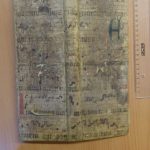Fragments from the same codex:
Budapest, University Library, cover of Inc. 260 (F 722)
Szombathely, Diocesan Library, sine sign.
Szombathely, Diocesan Archives, 48/E. fasc. 3
Budapest, National Széchényi Library, cover of Inc. 387
The fragment belongs to the diocesan Esztergom graduale, from which, during the intensive fragment-research of the latter years four further folios turned up in Budapest and Szombathely collections. The original codex presumably was written in the same scriptorium as the two antiphonals of the Cathedral Library of Esztergom (ms. I. 3c-d). See the description of F 722.
The results of the detailed examination of the notation confirm the inherence of the fragments: a mutual feature e.g. is the design of the f-key, which’s half-punctum is always cut sharply in the middle by the inner frame line, and even the dimensions (systems, staff distances) are the same on the fragments. At the same time the notation of the fragments can be related to the notation of the Esztergom Antiphonals mentioned above (Cathedral Library of Esztergom, Ms. I.3c and 3d), but the thought of codex pairs is excluded by the differences in the editing. The notation of the antiphonal “d” is more rigid, more standardized and has 9 staves on each folio, while the graduale, similarly to the antiphonal “c” has 8 staves. In addition, in the codex “c” Czech neume constructions (pes, scandicus, square custos) can be found, which seems to be relevant differences. Further analogies can be found in the fragment catalogue of Eva Veselovská (http://cantus.sk/); these findings can relate to the same school or scriptorium, even if each fragment has some unique features.
In the course of the examination it seemed, that the differences in the construction ares overwritten by the deeper connection of the notations: the scores show such high grade of correspondence, that their origin in the same workshop is expectable. The correspondence is well-perceivable in the design of the neumes, in the way of their articulation and conjunction, in the width of the pen, in the rate of stylization, in their sense of taste. The neume inventory with its perfectly aligning state of the loosening of conjunct neumes indicates scries/notators with the same level of preparedness. Where this scriptorium could have been? We imagine behind the notation a multi-national church institution with flourishing writing culture in Northern Hungary (today Slovakia), in which the scribes cultivated essentially the same notation, they only adjusted the ratios of the mixture, supposedly based on their individual preferences, education and descent, emphasizing once the Czech, in other cases the Hungarian or German elements.
Gabriella Gilányi
Zsuzsa Czagány




